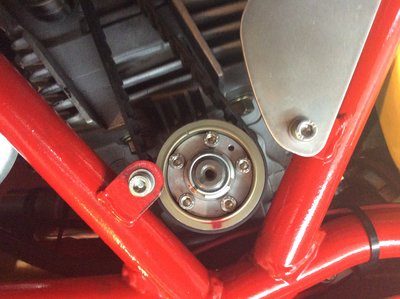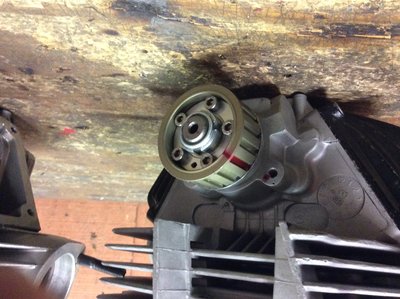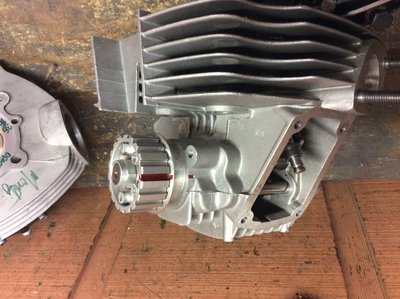The pitfalls of putting two Horizontal (O) 900-based (SS, ST2, ie) cams in Pantah heads. I am going to come back and fill this in bit by bit. And try to make some past postings more clear. First the photos, before I lose them. Later, MikeV
The cam pulley for the V head using any reverse-head H cam, like a 900SS, is about 160 degrees off the stock Pantah V cam after it is installed on the cam with a key. If the original mark on that cam cog is used for belt installation that is a certain disaster. 160 degrees is eight notches on the cog, so as a Start Point that mark must be moved forward, as the cog turns counter-clockwise. Either count eight including the existing mark, or count seven more notches out from the original dot. Using that new mark, you should also see that the V intake valve is just a smidgen from full opening when the Horizontal (O) cam is at TDC --- one more notch turn and it will start to close very quickly. You can eye-test that looking thru the plug hole, and by flipping the head over on the bench to see it. Also, you can test the TDC mark by moving the pulley forward and back, and feel the resistance (and see) as each valves starts to lift — usually from two to three slots in either direction. Check out the Horizontal head to get an idea. You will be in the ballpark for degreeing the cams. It is better to do a first installation with no pistons, but if they are installed just don't try to overcome any resistance --- that means you are off, or you have some other clearance problem. After finding TDC for the V head you can add a mark on the head just below the front 6mm hole for the rubber belt cover. Once the V cam is that close then offset keys or adjustable cogs can be used for dialing the cams. The adjustable cogs are light, and pretty, and those dinky offset keys are not cheap or readily available. .
Anyway, that method worked on F1 heads on the LS clone with 900ss cams set at 109 degrees on center, and on a set of Pantah heads that Carlo put 35 & 41mm valves in. And now for two 900ie cams in the TT2, and two ST2 cams in the F1/TT1.
Now others can correct me. This has been done before by many. Whatever you do please be sure and confident about the opening and closing of the replacement H cam in place of a V, and that when the belts are installed both cam/valve actions mimic the original sequence.
Another PS: I think when Palmer said punching marks he means the dots and/or small slashes that the racers and NCR put on the heads to replace those removed if the rubber plates are not installed. They show up in all kinds of photos of the vintage bikes --- and Palmer's engines --- I guess. I punch a little dot, and use blue on the H head and red on the V head, and also mark the timing shaft cog the same way. Plus I mark the V head TDC on the latter.
The major advantage to using 900 cams over “old school” race cams is that they can be installed in Pantah heads with much smaller static valve-to-valve clearances. I will post some representative photos of both in another posting later in the week.
This was corrected/modified/embellished on Oct 24, 2023 from a prior posting.
An adjustable cam pulley (thanks Carlo) re-marked with a red dot for the installation of a 900-based Horizontal cam in the Pantah Vertical head.
Attachment:
 IMG_1234.jpeg [ 1.09 MiB | Viewed 36943 times ]
IMG_1234.jpeg [ 1.09 MiB | Viewed 36943 times ]
This is TDC for a Vertical head; the new mark is found working from here.
Attachment:
 IMG_1218.jpeg [ 1.04 MiB | Viewed 36950 times ]
IMG_1218.jpeg [ 1.04 MiB | Viewed 36950 times ]
The new mark used when installing belts, with the Horizontal head at TDC. Standard procedure once you have this marked.
Attachment:
 IMG_1223.jpeg [ 1.12 MiB | Viewed 36950 times ]
IMG_1223.jpeg [ 1.12 MiB | Viewed 36950 times ]
Again, the new marking in red, with the original being the small hash mark at the bottom right (about 5 o’clock) on the pulley. Going clockwise it is now 200 degrees different (10 slots center-to-center), and going counter-clockwise 160 degrees different (8 slots).




